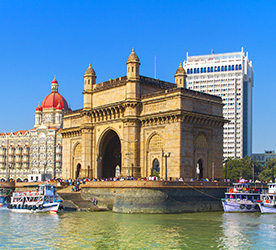
MONTHLY MUSINGS
The Mango Affair
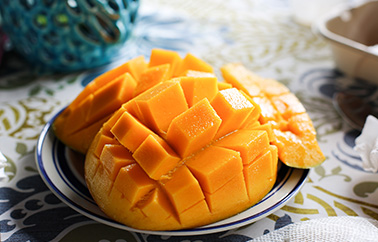
From March until the end of July the luscious and exotic mango with its different varieties and hues - from golden to saffron to tender green - becomes a sort of a national obsession in India. For rural India, mango season is about lazy summer vacations where children would pluck them straight from the tree and eat them raw with salt, chilli, and a dash of mustard oil. One of our immersive experiences for guests visiting India during summer is a picnic in a mango orchard. Freshly plucked mangoes are put in buckets of cold water and are to be eaten by hand. Guests are taught how to make a small incision at the top of the mango, squeeze the fruit gently and suck at the deliciously cold, sweet juice. It is a fun experience where it is all right to lick off the juice trickling down from the chin to the wrist. Nobody will judge you. That’s how it is done in India, in delight, probably for the past 4000 years.
The mango is more than just the undisputed king of fruits in India where nearly 45 percent of the world’s mangoes are grown; with over 1000 varieties and a staggering 20 million tonnes annually. It is an intrinsic part of India’s history, culture, religion, art, poetry, literature, and other forms of creative expression such as textiles. Ganesha, the elephant-headed Hindu God holds a ripe mango in one hand which symbolises prosperity. No Hindu wedding is complete without mango leaves which are considered auspicious.
The mango has found mention in ancient Indian scriptures that forbade the felling of mango trees. The Buddha is said to have received a mango grove as a gift so that he could rest under its shade. Amrapali, the stunningly beautiful courtesan of the Republic of Vaishali (in present-day Bihar of Eastern India, around 500 BC) who brought two kingdoms to war was named after the exotic fruit. She later renounced everything and became a Buddhist nun.
The mango, described by 13th century Sufi poet Amir Khusru, as Naghza Tarin Mewa Hindustan (the fairest fruit of India) has seduced emperors, kings, queens, and invaders alike. It has spawned an entire subgenre of summer cuisine which was once patronised by royalty across India. Politically, the mango has been an empire builder, an alliance maker, and a symbol of victory. It is said that Babur, the first Mughal emperor decided to stay back in India only after he was made to taste the mango. His descendant Aurangzeb, the sixth in the line, sent mangoes to the Shah of Persia while seeking his support during the tussle for the throne of Delhi. The yellow-golden variety of mango called Chausa was introduced to celebrate the Afghan general Sher Shah Suri’s victory over Humayun, Babur’s son. Humayun, even during his brief exile after his defeat, couldn’t give up his fondness for the mango and kept a good supply of the fruit running through a well-established network of spies.
Eventually, it was the Portuguese who took the mango from India and introduced it to the rest of the world some 400 years ago. They introduced grafting on mango trees to produce the Alfonso variety, considered the best among all. It was named after the Portuguese general Afonso de Albuquerque who helped establish the Portuguese colony in Goa.
The International Mango Festival held on July 22 every year in Delhi is a fantastic opportunity to hear more stories about the king of fruits and try the juicy flavours of more than 400 varieties from different parts of the country.
WHERE TO STAY

Anand Kashi by the Ganges – IHCL Seleqtions, Rishikesh, Uttarakand
Anand Kashi by the Ganges is the newest addition to the IHCL family. Spread across three acres of pristine Himalayan terrain, Anand Kashi was the erstwhile residence of the Maharaja of Tehri Garhwal. Surrounded by lychee and mango trees, this beautiful heritage property near Rishikesh offers twenty-four themed rooms with views of the Ganges River and the mountains. The hotel is designed around the Vedic panchamahabhuta philosophy showcasing Garhwali architecture with a contemporary twist as well as breath-taking views of the lofty mountain ranges and the Ganges. Start your day with breakfast at the Ganga deck, have lunch at Ana Rasa, the all-day restaurant, enjoy sundowners at Amrit Tara, the panoramic terrace bar, before wrapping it up with a dinner at one of the two Riverside Pavilions. Guests may participate in an adventure activity, join up for a yoga session, pamper themselves with a rejuvenating session at the Amrit Kashi spa, take a dip in the sacred waters at their private beach or simply relax by the pool. A resident priest performs the Ganga Aarti three times a week at the property's historic Shiva temple.
Weaving it into an itinerary
Routing: Delhi – Corbett – Haridwar - Rishikesh – Delhi
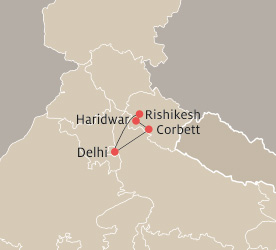
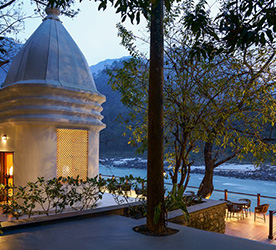

Asanji Wadi, Alibaug – Ama Stays & Trails
Nestled in the middle of a lush Mango Orchard in Alibaug, Asanji Wadi is a beautiful four-bedroom villa that offers travellers a relaxed vacation packed with simple, pleasant activities and experiences unique to this charming coastal town. Asanji Wadi, which roughly translates to ‘our farm’ in Kutchhi, is a suitable name for this picturesque abode, as it was built from materials retrieved from the owners’ ancestral home in Bhuj, Kutch. With high ceilings, stone flooring, a wooden staircase and pillars, the interior of this home exudes a warm and old-world vibe.
Weaving it into an itinerary
Routing: Mumbai – Uran - Alibaug – Pune – Mumbai


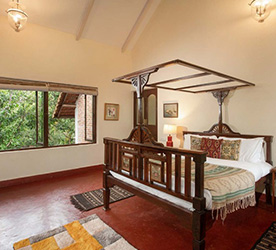
The Mango House, Alibaug – Ama Stays & Trails
As one enters The Mango House, Alibaug, it takes a moment to look past the trees to see the bungalow, which stands inconspicuously, like a natural extension of the verdant surroundings. The bungalow’s tree-shaded extensions and the presence of shrubs throughout attest to how lovingly the place's original residents, the Mango trees, were managed as the bungalow grew around them. This four-bedroom bungalow has received numerous awards and plaudits for its sophisticated yet modest architecture, which combines a palette of natural and tactile materials such as brick, stone, and wood to match its rich natural surroundings. Guests can immerse themselves in a deep sense of culture and tradition unique to the region, while also connecting with nature in its pristine form.
Weaving it into an itinerary
Routing: Mumbai – Alibaug – Ganpatipule - Goa





